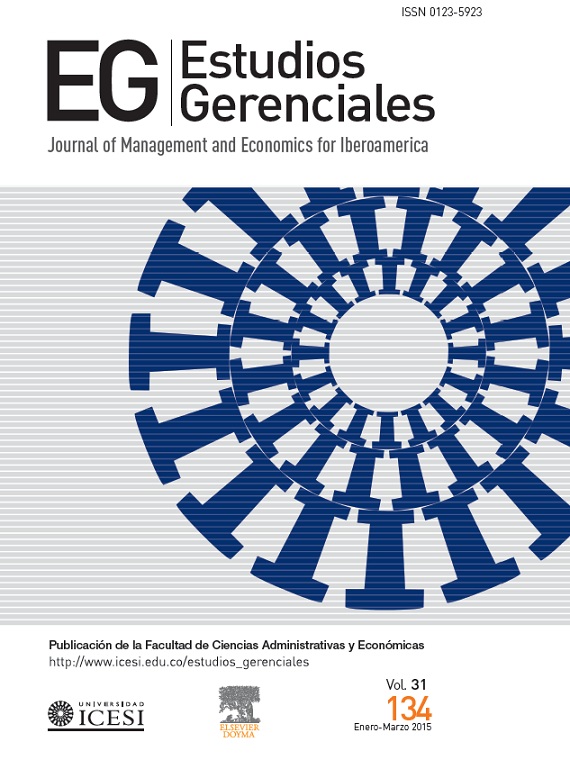La efectividad de la publicidad oposicional
DOI:
https://doi.org/10.1016/j.estger.2014.08.005Palabras clave:
Publicidad oposicional, Complejidad, RecordaciónResumen
El propósito de este estudio es analizar la viabilidad de la publicidad oposicional en Chile. Los datos fueron recolectados a través de experimentación controlada, a través del uso de un anuncio impreso para un nuevo automóvil en donde se manipularon los elementos visuales y verbales (oposicionales vs. no oposicionales). Los hallazgos sugieren que los anuncios oposicionales pueden ser menos eficaces en la recordación del anuncio, a pesar de ser percibidos menos complejos por los participantes. Mientras que una investigación experimental no es suficiente para establecer la no superioridad de la publicidad oposicional en Chile, los resultados apoyan la idea de que la publicidad oposicional podría no ser más eficaz que la publicidad no oposicional para muchas campa˜nas de marketing en Chile.Descargas
Referencias
Ang, S. H., Lee, Y. H. y Leong, S. M. (2007). The ad creativity Cube: Conceptualization and initial validation. Journal of the Academy of Marketing Science, 35, 220–232.
Armstrong, J. S. (2010). Persuasive Advertising: Evidence-Based Principles. New York: Palgrave Macmillan.
Baack, D. W., Wilson, R. T. y Till, B. D. (2008). Creativity and memory effects. Journal of Advertising, 37, 85–94.
Bayuk, J. B., Janiszewski, C. y Leboeuf, R. A. (2010). Letting good opportunities pass us by: Examining the role of mind-set during goal pursuit. Journal of Consumer Research, 37, 570–583.
Bellman, S., Schweda, A. y Varan, D. (2012). Interactive TV advertising: iTV ad executional factors. Journal of Business Research, 65(6), 831–839.
Calder, B., Phillips, L. y Tybout, A. (1981). Designing research for application. Journal of Consumer Research, 8(2), 197–207.
Cook, T. y Campbell, D. (1975). The design and conduct of experiments and quasiexperiments in field settings. In M. Dimmette (Ed.), Handbook of Industrial and Organisational Research (pp. 223–326). Chicago: Rand McNally.
Geissler, G., Zinkhan, G. y Watson, R. (2001). Web homepage complexity and communication effectiveness. Journal of the Association for Information Systems, 2, 1–44.
Golder, P., Mitra, D. y Moorman, C. (2012). What is quality? An integrative framework of processes and states. Journal of Marketing, 76(4), 1–23.
Hall, E. (1976). Beyond Culture. New York: Doubleday.
Heiser, R., Sierra, J. y Torres, I. (2008). Creativity via cartoon spokespeople in print ads: Capitalizing on the distinctiveness effect. Journal of Advertising, 37(4), 75–84.
Hofstede, G. (2001). Cultures Consequences: Comparing Values. Behaviors Institutions and Organizations across Nations (2.a ed.). Thousand Oaks, CA: Sage Publications.
Homer, P. M. y Batra, R. (1994). Attitudinal effects of character-based versus competence-based negative political communications. Journal of Consumer Psychology, 3, 163–186.
Jeon, J. O. y Beatty, S. E. (2002). Comparative advertising effectiveness in different national cultures. Journal of Business Research, 55, 907–913.
Jeong, S. H. (2008). Visual metaphor in advertising: Is the persuasive effect attributable to visual argumentation or metaphorical rhetoric? Journal of Marketing Communications, 14, 59–73.
Krishen, A. y Homer, P. M. (2012). Do opposites attract? Understanding opposition in promotion. Journal of Business Research, 65(8), 1144–1151.
Krishen, A. S., Nakamoto, K. y Herr, P. (2008). The dichotomy heuristic in choice: How contrast makes decisions easier. Germany: VDM-Verlag.
Manzur, E., Uribe, R., Hidalgo, P., Olavarrieta, S. y Farías, P. (2012). Comparative advertising effectiveness in Latin America: Evidence from Chile. International Marketing Review, 29(3), 277–298.
Mercanti-Guerin, M. (2008). Consumers perception of the creativity of advertisements: Development of a valid measurement scale. Recherche et Applications en Marketing, 23, 97–118.
Mick, D. G., Broniarczyk, S. M. y Haidt, J. (2004). Choose, choose, choose, choose, choose, choose, choose: emerging and prospective research on the deleterious effects of living in consumer hyperchoice. Journal of Business Ethics, 52, 207–211.
Mooij, M. y Hofstede, G. (2010). The Hofstede model applications to global branding and advertising strategy and research. International Journal of Advertising, 29, 85–110.
Sedikides, C. y Skowronski, J. J. (1991). The law of cognitive structure activation. Psychological Inquiry, 2, 169–184.
Publicado
Número
Sección
Licencia
Los autores de artículos serán responsables de los mismos, y por tal no comprometen los principios o políticas de la Universidad Icesi ni las del Comité Editorial de la revista Estudios Gerenciales. Los autores autorizan y aceptan la cesión de todos los derechos a la revista Estudios Gerenciales, tanto en su publicación impresa como electrónica. Luego de publicado el artículo, puede ser reproducido sin autorización, mencionando autor(es), título, año, volumen, número y rango de páginas de la publicación, y como fuente: Estudios Gerenciales (abstenerse de usar Revista Estudios Gerenciales).








